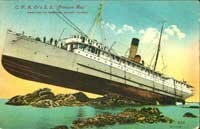
 |
|
||||||||||||||||||||||||
|
America's Territory
Marine Transportation
 C.P.R. Co's S.S. "Princess May" wrecked on Sentinal Island, Alaska. Bow of ship raised high above the rocks. Several figures on the foreward deck. Hand tinted postcard. The challenges of remoteness, a small population, seasonal markets, small ports with limited facilities, and navigational problems limited the number of shipping companies operating in Alaska. Only the Alaska Commercial Company provided occasional steamship service to its trading posts. In 1889, the Pacific Coast Steamship Company started carrying freight and passengers to Alaska, and in 1894 the Alaska Steamship Company started regular service. First class passenger fares from Seattle to Juneau were $52, and freight rates were $11 per ton. After news of the Klondike gold discoveries reached West Coast ports in July 1897, more than 8,000 people headed for Alaska that summer and fall. The shipping companies, and several hastily organized companies, frantically sought ships to send to Alaska. After 1900 there were more shipping companies serving Alaska, but they cooperated with each other to charge high rates, which Alaskans resented. In 1908, a group known as the Alaska Syndicate, with funds from J.P. Morgan and the Guggenheim sons, bought the Alaska Steamship Company so they could mine copper in the Wrangell Mountains. They merged the company with, the Northwestern Steamship Company, which almost gave them a monopoly. It had a fleet of 18 vessels serving Alaskans from Ketchikan to Kotzebue. Several large salmon canners maintained private fleets of ships. Company ships took workers and supplies from West Coast ports to canneries at the beginning of the fishing season and took the workers and canned salmon back at the end of the season. The Alaska Packers Association, known for its "Star fleet" with ships named Star of India and Star of Alaska, operated a private fleet from 1893 to the 1950s.  Governor Parks' 1928 Alaska Tour Itinerary Plates from photo album, detailing Governor Parks' 1928 Alaska Tour. Map of Alaska, showing air and surface routes. During World War II, the federal government took control of most U.S. registered ships for the war effort, including fifteen ships of the Alaska Steamship Company. After the war, the Alaska shipping industry changed. Only two major companies, Alaska Steamship Company and Northland Transportation Company served Alaska, both owned by the Skinner and Eddy Corporation in Washington. Before the war, 42 ships served Alaska; in 1948 only seven. The change was due to the end of federal subsidies, rising labor costs, and new competition from truckers and air carriers. The Alaska Steamship Company started to use tugs and barges and container ships. Tugs and barges could travel faster and operated with smaller crews 5 to 7 workers as compared to 30 to 40 on freighters. Containers could be trucked, lifted on and off, and trucked away, allowing faster loading.. The company stopped passenger service in 1954. Air fare from Seattle to Seward was $105 at the time and took a day. The ocean liner fare was $115 and took about a week. The new State of Alaska started a public ferry system, called the Alaska Marine Highway system, to serve coastal Alaska communities in 1963. Ferries ran from Prince Rupert, British Columbia, to Skagway , with stops along the way. The Malaspina, the Matanuska, and the Taku, could carry 500 passengers and 108 vehicles. The system was soon extended to Southcentral Alaska, and in the early 1980s to several Aleutian Island communities. The changes in the industry finally forced the Alaska Steamship Company out of business in 1974. Today Alaskans still rely heavily on ocean shipping. The bulk of the freight brought north is by ship, and Prudhoe Bay oil is shipped south in supertankers.
|
|||||||||||||||||
|